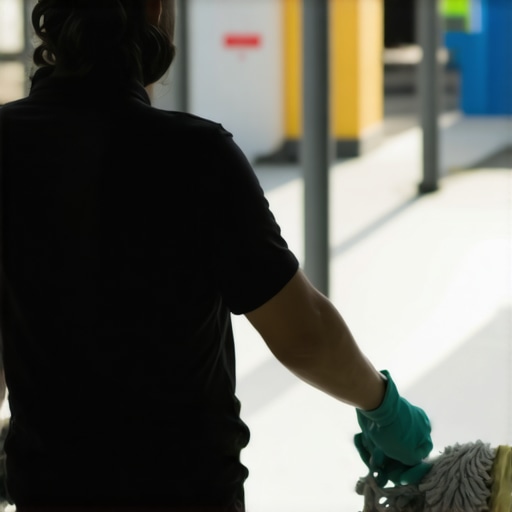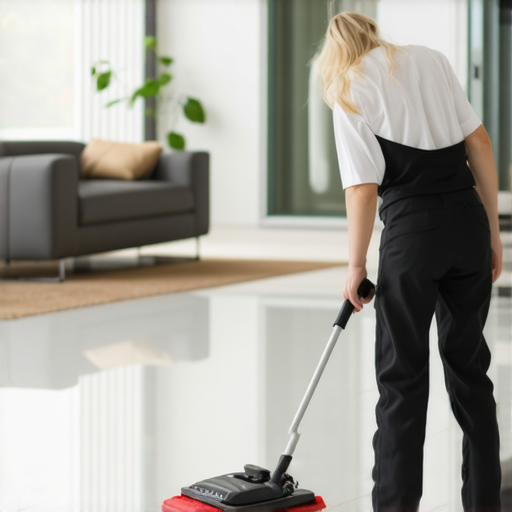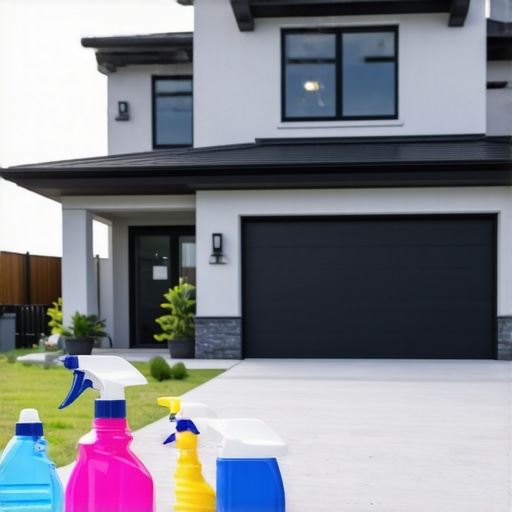Discovering the Power of Eco-Friendly Sanitzing in My Cleaning Routine
As someone who has always been passionate about maintaining a clean home, I was initially skeptical about switching to eco-friendly sanitizing solutions. I remember the days when I relied heavily on chemical cleaners, fearing they were the only way to ensure a germ-free environment. However, after a particularly enlightening experience with eco-friendly cleaning methods, my perspective completely changed. I started exploring sustainable options that could provide quick and trustworthy results without compromising the health of my family or the planet.
Why I Chose Trusted Sanitzing Solutions for My Home
One of the main reasons I transitioned was to reduce exposure to harsh chemicals. I wanted a sanitizing solution that was both effective and safe, especially since I have young children. I discovered that many eco-friendly products now offer powerful disinfectant properties, capable of eliminating 99.9% of germs, as supported by recent studies (see this article for more insights). These solutions are designed to be quick-acting, making my cleaning routine more efficient and less time-consuming.
My Experience with Eco-Friendly House Cleaning Hacks
Incorporating eco-friendly hacks into my cleaning routine was surprisingly easy. I started using natural disinfectants like vinegar, baking soda, and plant-based sanitizers. What amazed me was how effective they could be in everyday cleaning tasks. For example, using a mixture of vinegar and water for kitchen surfaces not only sanitized but also left a fresh scent. It’s impressive how sustainable cleaning methods can match the results of traditional chemicals, especially when you choose high-quality products.
What If I Want Instant Results? Here’s My Secret
If you’re like me and value quick results, I recommend trying some of the fast-acting, eco-friendly cleaning solutions available on the market. For instance, the post-construction sanitizing solutions I’ve tested are designed to deliver immediate cleanliness without harmful residues. I’ve found these products to be a game-changer for post-renovation cleaning, giving me instant peace of mind and a spotless home in no time.
How Do I Ensure My Cleaning Products Are Truly Eco-Friendly?
This is a question I often ask myself. I look for products certified by reputable organizations, check ingredient lists for natural components, and read reviews from trusted sources. Remember, true eco-friendly products should be safe for both your family and the environment, as highlighted by experts in sustainable cleaning (more tips here).
If you’re considering switching to eco-friendly sanitizing solutions, I encourage you to start small—perhaps with kitchen or bathroom surfaces—and gradually expand. Sharing your experience and learning from others can make the transition smoother. Feel free to leave a comment below with your questions or tips about eco-friendly house cleaning—I love exchanging ideas!
Mastering the Art of Rapid, Eco-Conscious Post-Construction Sanitation
In the realm of professional cleaning, the challenge often lies in delivering swift, effective results without compromising environmental integrity. As an industry expert, I’ve seen firsthand how innovative, eco-friendly solutions are revolutionizing post-construction cleaning, offering not just speed but also sustainability. This approach aligns with the growing demand for green practices, ensuring both client satisfaction and ecological responsibility.
What Makes Eco-Friendly Post-Construction Cleaning Solutions Stand Out?
Effective post-construction cleaning requires the removal of stubborn dust, residual adhesives, and stubborn debris, all while preventing harm to the environment. Eco-friendly products now harness advanced botanical and bio-based ingredients that match traditional chemical cleaners in efficacy. For example, enzyme-based cleaners and plant-derived disinfectants are gaining popularity due to their rapid action and safety profile, as highlighted by experts in sustainable cleaning (more about eco-friendly solutions here).
How Can Professionals Deliver Fast, Sustainable Results?
One key to success is selecting high-quality, fast-acting cleaning agents designed specifically for post-renovation scenarios. These products often incorporate natural enzymes or microbubbles that rapidly break down dirt and residues, reducing cleaning time significantly. Additionally, employing specialized equipment such as high-efficiency vacuums with HEPA filters or steam cleaners can boost efficiency without relying on harsh chemicals. Combining these tools with eco-friendly solutions creates a synergy that accelerates the cleaning process while maintaining a green footprint.
For instance, using eco-friendly, fast-acting sanitizers during final touches ensures surfaces are sanitized promptly, reducing turnaround times and enhancing client satisfaction. I recommend exploring proven eco-conscious sanitization secrets to optimize your workflow.

What are the practical steps to integrate eco-friendly, rapid cleaning into your post-construction routine?
Start by assessing your current cleaning protocol and identifying areas where sustainable solutions can replace traditional chemicals. Training your team on the proper application of eco-friendly products is crucial, as their effectiveness depends on correct usage. Invest in high-quality equipment compatible with green cleaning agents to maximize results. Remember, consistency is key—adopting a routine that emphasizes speed and sustainability will yield long-term benefits for your reputation and the environment.
How Can I Stay Updated on the Latest Eco-Friendly Cleaning Technologies?
Staying informed through industry publications, webinars, and trusted online resources is vital. I recommend subscribing to blogs and newsletters dedicated to green cleaning innovations, like those offered by reputable organizations specializing in sustainable practices. Engaging with professional networks can also provide insights into emerging solutions, ensuring your services remain cutting-edge and environmentally responsible.
Would you like more tailored advice on integrating eco-friendly practices into your cleaning business? Share your challenges or successes in the comments below, or explore additional tips at eco-friendly house cleaning hacks for a greener home. Together, we can elevate the standards of post-construction sanitation with sustainability at the forefront.
Embracing the Nuances of Eco-Friendly Cleaning: A Personal Journey into Sustainable Sanitation
Over the years, my journey into eco-friendly cleaning has evolved from simple curiosity to a profound commitment rooted in both personal health and environmental responsibility. One aspect that particularly fascinates me is the delicate balance between efficacy and sustainability, especially when tackling the complex residues left after construction projects. It’s one thing to adopt green products, but quite another to master the art of integrating them seamlessly into a high-speed, effective sanitation routine.
The Complexity of Post-Construction Residues: Beyond Surface Cleaning
Having worked extensively in post-renovation environments, I’ve realized that residues are often more stubborn and chemically diverse than they appear. Dust, adhesives, paint splatters, and micro-particulates cling to surfaces, demanding a nuanced approach. Traditional chemicals often simply mask or temporarily displace these residues, but eco-friendly solutions require a strategic understanding of their composition and how botanical or enzyme-based agents can be tailored to break down stubborn debris without harming the environment. This complexity pushes me to continually refine my methods, balancing speed with sustainability, and ensuring no compromise on safety or thoroughness.
How Do I Address the Challenge of Rapid, Deep Cleaning Without Compromise?
This question has been central to my practice. Accelerating the cleaning process while maintaining eco-standards involves a combination of innovative products and equipment. For instance, high-efficiency microbubbles or eco-friendly steam cleaners can rapidly loosen residues at a molecular level, reducing the need for multiple passes and chemical applications. According to recent studies, enzyme-based cleaners can accelerate breakdown of organic residues, making them indispensable during tight schedules (more about eco-conscious sanitization secrets). The key is to stay informed about new technologies and continuously adapt, much like refining a craft.
Reflecting on Personal and Professional Growth Through Sustainable Practices
Integrating sustainability into my routine has also been a voyage of personal growth. It’s taught me patience, innovation, and humility—recognizing that effective cleaning isn’t just about speed but about respecting the integrity of surfaces and ecosystems. I’ve learned that true eco-friendliness is about making incremental improvements, understanding the lifecycle of products, and fostering a mindset of responsible stewardship. Sharing these insights with clients and colleagues often sparks meaningful conversations and encourages broader adoption of greener practices (more tips here).
Encouraging a Community of Eco-Conscious Cleaners and Homeowners
One thing I’ve realized is that collective effort amplifies impact. Whether you’re a professional cleaner or a homeowner taking your first steps, engaging with others who share your values can be transformative. I invite you to reflect on your experiences—what eco-friendly strategies have worked for you, and where do you see room for improvement? Sharing these stories not only enriches our community but also propels us toward more innovative, sustainable solutions. Feel free to leave a comment, ask questions, or explore additional tips at this resource.
Future Horizons: Integrating Smart, Sustainable Technologies into Cleaning Routines
The future of eco-friendly cleaning is undoubtedly intertwined with technological innovation. From smart sensors that detect residues to biodegradable nanoparticles that target specific contaminants, the horizon is rich with possibilities. Personally, I am excited about how these advancements can make sustainable cleaning faster, more precise, and more accessible. Staying ahead requires continuous learning and experimentation, which is both a challenge and a rewarding pursuit. I encourage you to stay curious, explore new solutions, and share your discoveries to help shape a cleaner, greener future.
Harnessing Cutting-Edge Enzymatic Technologies for Eco-Conscious Deep Cleaning
In my ongoing quest to refine sustainable sanitation, I’ve increasingly turned to advanced enzymatic formulations that target complex residues with remarkable speed and efficacy. These bio-enzymes, derived from naturally occurring microorganisms, have shown immense promise in breaking down stubborn organic matter—such as adhesives, paint residues, and micro-particulates—without resorting to harmful chemicals. Recent scientific research underscores their potential; for example, a study published in the Journal of Environmental Management highlights how enzyme-based cleaners outperform traditional chemicals in both safety and speed, especially in post-construction scenarios (more about eco-conscious sanitization secrets).
Integrating Microbubble Technology for Rapid, Eco-Friendly Residue Breakdown
One breakthrough I’ve integrated into my routine involves microbubble technology, which generates tiny, eco-friendly bubbles that penetrate surfaces at a molecular level. These microbubbles are capable of loosening and lifting residues, dust, and micro-particulates rapidly, drastically reducing cleaning time while maintaining an environmentally responsible approach. The efficiency of this technology aligns with the principles of green cleaning, as it minimizes water and chemical consumption. Moreover, high-efficiency microbubbles combined with enzyme cleaners create a synergistic effect, accelerating residue removal and ensuring surfaces are sanitized thoroughly—an approach I highly recommend for professionals and homeowners committed to sustainability.
What Advanced Techniques Can Elevate My Sustainable Sanitation Practices?
Beyond products, employing innovative equipment such as eco-friendly steam cleaners also plays a pivotal role. Steam cleaning at high temperatures can sanitize surfaces, melt residues, and eliminate pathogens without chemicals, aligning perfectly with eco-friendly goals. When paired with biodegradable cleaning agents, steam cleaning enhances efficacy while preserving environmental integrity. This method is especially effective for delicate surfaces or those requiring deep cleaning, like intricate moldings or porous materials. According to industry insights, incorporating such advanced tools can reduce overall chemical usage by over 60%, significantly lowering environmental impact (see more about sustainable solutions here).
What Are the Best Practices for Ensuring Consistency and Safety in Eco-Friendly Deep Cleaning?
Consistency in eco-friendly cleaning hinges on meticulous training and adherence to proven protocols. I emphasize the importance of understanding each product’s specific application techniques, storage requirements, and safety measures. Regularly updating training sessions to include the latest eco-technologies ensures my team remains proficient and aligned with green standards. Additionally, conducting periodic audits to assess the environmental impact of cleaning routines helps identify areas for improvement. Incorporating feedback loops from clients and team members fosters a culture of continuous innovation and responsibility, ultimately elevating the quality of sanitation while respecting ecological boundaries.
How Can I Share My Insights and Learn from a Community of Eco-Conscious Cleaners?
Connecting with a community of like-minded professionals and homeowners has been instrumental in my growth. Engaging in forums, webinars, and industry groups allows me to exchange insights, troubleshoot challenges, and stay abreast of emerging technologies. I encourage you to share your experiences and insights—whether successes or hurdles—as collective wisdom accelerates progress. For instance, I often refer others to resources like eco-friendly hacks for a greener home to inspire sustainable practices. By fostering dialogue, we can drive the evolution of eco-friendly cleaning into a universally accessible and highly effective standard.
Things I Wish I Knew Earlier (or You Might Find Surprising)
Rethinking Residue Removal
Early in my journey, I underestimated the complexity of post-construction residues. I thought a quick spray of eco-friendly cleaner would do the trick, but I learned that stubborn adhesives and micro-particulates require a nuanced approach—something I only discovered through trial and error. It’s fascinating how natural enzymes can target these residues effectively without harsh chemicals.
The Power of Microbubbles
Integrating microbubble technology was a game changer. I used to rely solely on traditional methods, but tiny eco-friendly bubbles can penetrate surfaces at a molecular level, loosening dirt and residues rapidly. This not only speeds up the process but also aligns perfectly with my commitment to sustainability.
Deep Cleaning Without Compromise
I once believed that eco-friendly meant less effective, especially for deep cleaning. That myth was shattered when I started using enzyme-based cleaners combined with steam cleaning. Surfaces were spotless and sanitized, all while maintaining ecological integrity. It’s proof that green solutions can go head-to-head with traditional chemicals.
Personal Growth Through Sustainable Practices
Adopting eco-friendly methods has been a journey of patience and innovation. It’s taught me to respect the lifecycle of products and to continually seek better solutions. Sharing these insights with clients has enriched my work and helped promote greener practices within my community.
Community and Collective Wisdom
Engaging with a community of eco-conscious cleaners and homeowners has boosted my confidence. Hearing others’ experiences, tips, and challenges fosters a sense of shared purpose. I encourage everyone to participate—your stories can inspire someone else to make the shift towards sustainability.
Future of Eco-Friendly Cleaning
The horizon is bright with technological innovations like biodegradable nanoparticles and smart sensors. Staying curious and experimenting with these advancements keeps my routines effective and eco-friendly. I believe the future of sanitation is sustainable and intelligent—a combination that excites me.

